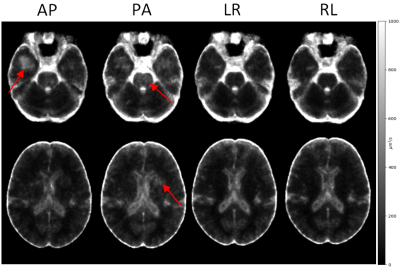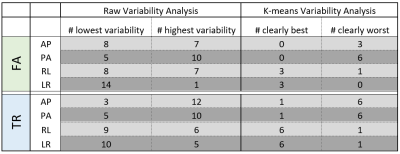Grayson Clark1, M. Okan Irfanoglu1, and Carlo Pierpaoli1
1QMI, NIBIB/NIH, Bethesda, MD, United States
1QMI, NIBIB/NIH, Bethesda, MD, United States
The reproducibility of DTI derived metrics varies among the data
acquired with different phase-encoding directions. Data acquired using LR/RL
phase-encoding directions were superior in reproducibility to AP/PA data in the
whole brain although regional variability was also observed.

Figure 1. Population-level standard deviation maps for TR
for all four phase-encoding directions. As evident in the temporal lobes of AP
and PA data, ghost artifacts originating from the eyes significantly increased
the variability in these regions. Additionally, in the Pons region, the
variability was again significantly higher in AP and PA data compared to RL and
LR. The reproducibility at mid-brain level was mostly similar for all
phase-encoding directions except a small region of high variability near the
caudate for the PA data.

Number of regions each PED produced the
lowest and highest variabilities. The columns labeled “# lowest" and "# highest" variability indicate the number of ROIs where a given PED yielded the lowest or highest raw standard
deviation values. The columns “# clearly best” and "worst” show the number of times the difference between the automatically computed "more reproducible" and "less reproducible" cluster centroids was more than 20%. These
values indicate an overall trend where LR and RL PED generally produced more
reproducible results and PA PED was the least reproducible.
